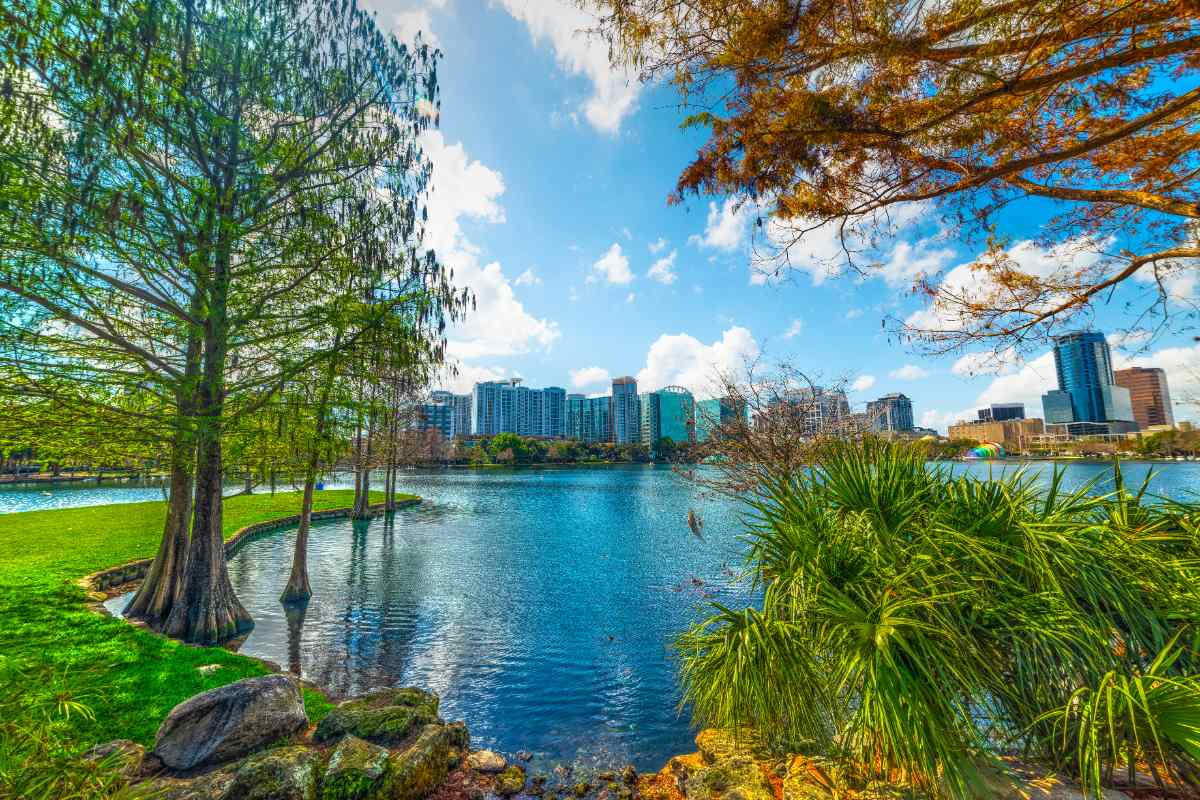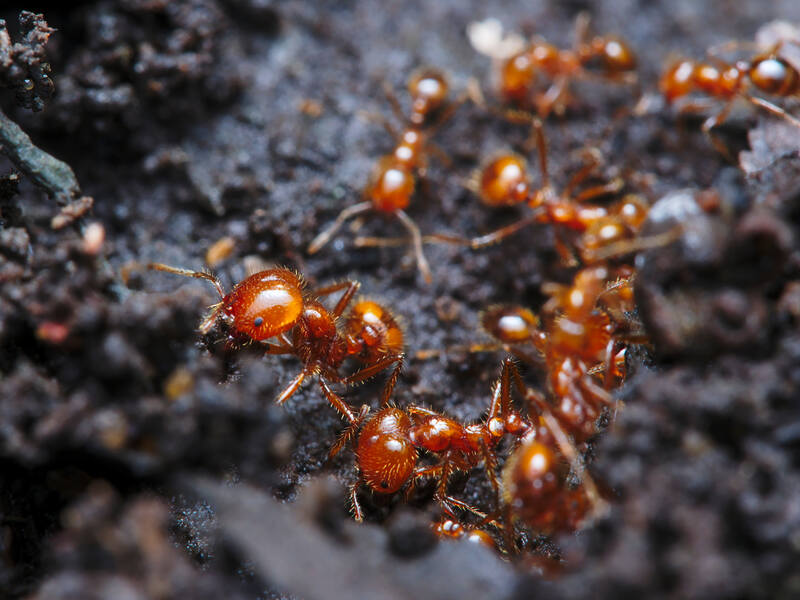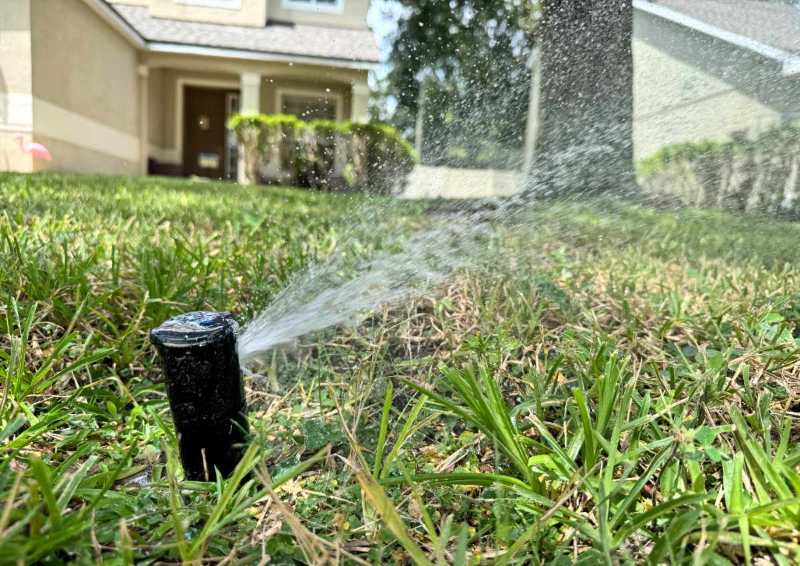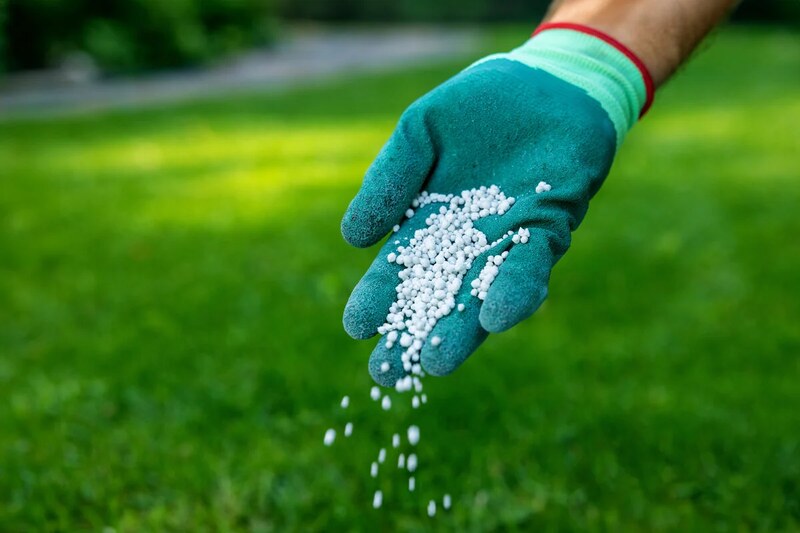
Spring lawn care in Orlando starts with testing the soil, applying herbicides, and gradually increasing irrigation and mowing frequency as the grass grows.
Hold off on the first fertilization until 50% of the lawn is green, and keep an eye out for chinch bugs and fungal diseases. Want to know more? This article includes practical spring lawn care tips for Orlando lawns with the best timing for each step and expert insights.
- 1. Clean Up the Yard (Early March)
- 2. Test the Soil (Early March)
- 3. Control Weeds in Spring (March-May)
- 4. Treat for Pests (March-May)
- 5. Prevent Diseases (March-May)
- 6. Gradually Increase Watering (March)
- 7. Start Mowing Regularly (Mid-March)
- 8. Remove Thick Thatch (April-May)
- 9. Aerate Compacted Soil (April-May)
- 10. Start Fertilizing (Late March-Early May)
- 11. Overseed and Repair (April-May)
1. Clean Up the Yard (Early March)
Planning for a healthy Orlando lawn? Start with spring cleanup. In early March, as the weather warms up, remove debris to improve airflow and sun exposure:
- Haul out any fallen branches, twigs, and palm fronds
- Gently rake fallen leaves
- Clean gutters and drainage ditches
2. Test the Soil (Early March)
Central Florida soils come with unique challenges that make periodic soil testing essential:
- Soils are typically rich in phosphorus, but some lawns can be deficient. You won’t know until you test the soil.
- Low potassium and micronutrients. The typical Orlando lawn has sandy soil, is low in organic matter (only about 1%), and doesn’t hold water and nutrients well.
- The average soil pH is 6.0 – 7.5, but it varies widely, so you can have a soil that’s too acidic or too alkaline, which prevents your grass from absorbing nutrients.
Collect a soil sample in early March and send it to the UF/IFAS Extension Soil Testing Laboratory in Gainesville to get the results by the time you start fertilizing the lawn. Or take it to your local Extension Office, and they will send it to the lab for you.
See Related:
- How Soil pH Affects Lawn Health
- How to Change Your Soil pH
- 6 Different Nitrogen Sources for the Lawn
- 5 Tell-Tale Signs Your Lawn Needs Fertilizer
3. Control Weeds in Spring (March-May)

In Central Florida’s warm climate, weeds germinate earlier and linger longer into the fall. Your best chance for effective chemical control is well-timed herbicides in the spring.
- Apply pre-emergent herbicides in late January to mid-February, as part of your Orlando winter lawn care.
- Plan a second application 4-6 weeks later to eliminate late-germinating weeds.
- Use post-emergent herbicides to control surviving weeds while they are young.
Here’s a herbicide application schedule to guide you, including the best time to target the most common Orlando lawn weeds:
| Weed Type | Best Time to Apply a Pre-emergent Herbicide | Best Time to Apply a Post-emergent Herbicide |
| Dandelions | Late January to mid-February *Soil temps reach 55 F | March-April |
| Crabgrass, chamberbitter, spotted spurge, Florida pusley | Late January to mid-February *Soil temps reach 55 F | April-May |
| Dollarweed, buttonweed | Late January to mid-February *Soil temps reach 55 F Less effective; they spread mainly through rhizomes | March-May |
| Goosegrass | The second week of March *Soil temps reach 60 F | April-May |
| Doveweed | Mid-March to Early-April *Soil temps reach 65 F to 70 F | May-June |
Note: Watering to activate herbicides is exempt from Orlando’s regular watering restrictions, provided you apply no more than 1/4 inch of water (or the amount specified on the product label) within 24 hours of application.
See Related:
4. Treat for Pests (March-May)

Spring’s arrival in Orlando brings more than just green grass — the warm, humid weather also awakens numerous lawn pests.
“Monitor chinch bugs and fire ant mounds; apply bait or insecticide as needed,” says Orlando LawnStarter Pro Vincente Vazquez of Cutting Edge Professional Landscaping.
Chinch bugs and fire ants are known troublemakers in Greater Orlando lawns, but they’re not the only ones. Here are the most common pests to watch for and treat by type of grass:
| Types of Grass | Most Common Pests |
| St. Augustine | Chinch bugs, sod webworms, and grubs |
| Bahia | Mole crickets, grubs |
| Bermuda | Mole crickets, billbugs, grubs |
| Centipede | Nematodes, ground pearls, and mole crickets |
| Zoysia | Billbugs, sod webworm, grubs |
Ticks live year-round in Central Florida but become more active mid-spring. They’re a serious health threat to your family and pets, so get rid of the ticks in your lawn as soon as you spot any.
Mosquitoes don’t damage grass, but their nasty bites can surely ruin your lawn experience. Plus, they carry dangerous diseases, and in Orlando’s humid summer, they will multiply like crazy.
Get rid of them DIY (here’s a guide to help you: “How to Get Rid of Mosquitoes in Orlando”), or call a pest control professional to do it for you.
| Hire an Orlando LawnStarter pro to get rid of mosquitoes in your lawn. Our customers pay our pros an average of $128 per mosquito prevention service and give them an average rating of 4.3. |
See Related: How to Get Rid of Florida Lawn Pests
5. Prevent Diseases (March-May)
Orlando’s warm and humid climate also favors the spread of fungal diseases. Stay vigilant from March through May, and when you spot trouble, hit back with fungicides before the problem spreads.
If fungi frequently infest your lawn, take the proactive approach and apply fungicides preventatively in the spring when the grass starts to green up.
Here are the most common diseases to monitor by type of grass in Orlando lawns:
| Type of Grass | Primary Concern | Other Common Diseases |
| St. Augustine | Gray leaf spot | Large patch, take-all root rot |
| Bahia | Dollar spot | |
| Bermuda | Large patch | Dollar spot, leaf spot and melting out |
| Centipede | Large patch | Dollar spot |
| Zoysia | Large patch | Dollar spot, rust |
6. Gradually Increase Watering (March)

Starting with the second Sunday in March, Orlando area watering restrictions allow 2 watering days per week, but your grass doesn’t need 1 to 1.5 inches per week in early spring. Increase the amount gradually.
Here’s a monthly schedule suggested by the University of Florida for Central Florida lawns watered 2 days a week:
| Month | Minutes per Session | Inches per Session |
| March | 15 | Approx. 1/4 inch |
| April | 36 | Approx. 1/2 inch |
| May | 57 | Approx. 3/4 inch |
To prevent overwatering and diseases:
- Water when you see signs of drought stress (footprints remain in wilted grass)
- Check the irrigation system
- Turn off the sprinklers when it rains (manual sprinklers)
- Ensure your rain sensor is functioning properly (automatic sprinklers)
“A broken rain sensor can lead to irrigation while it is raining,” explain Hannah Eason and Calvin Gardner, UF/IFAS Extension agents in Orange County. “It is not only wasteful, but it can create unfavorable conditions that may lead to diseases. It is also Florida law!” add the experts.
Orange County Utilities Water Division and Seminole County currently provide free irrigation system evaluations and replacement rain sensors at no charge.
The Orlando area is under watering restrictions year-round. March to May, follow these rules:
- Water in the morning between 4 a.m. and 9 a.m.
- Apply no more than 3/4 inches of water per session
- Water 1-2 times a week
- Follow the address-based schedule: Odd-numbered or no-address homes water on Wednesday and Saturday; even-numbered addresses water on Thursday and Sunday.
See Related:
7. Start Mowing Regularly (Mid-March)
Around mid-March, the lawn grows fast enough to require regular mowing. Let the grass get a bit overgrown before the first mow — it crowds the weeds and promotes deep roots.
Mowing height and frequency depend on the type of grass. Here are the recommendations for the best and most common grass types for Orlando lawns:
| Type of Grass | Optimal Mowing Height (inches) | Mowing Frequency (days) |
| St. Augustine | 3.5-4 | 5-14 |
| Bahia | 3-4 | 7-17 |
| Bermuda | 0.75-1.5 | 3-5 |
| Centipede | 1.5-2 | 10-14 |
| Zoysia | 1-2 | 10-14 |
Avoid cutting the lawn too short; it damages the grass and doesn’t reduce mowing frequency, says Orlando LawnStarter Pro Kody Robinson of ProCutz Lawncare Landscaping LLC.
“In Orlando’s hot, humid climate, especially with St. Augustine or bahiagrass, scalping causes brown, patchy lawns, thriving weeds, weak root systems, and burnout during dry weeks,” he says.
| Get your lawn perfectly mowed by an Orlando LawnStarter pro. Our pros average $51 for mowing a 1/4-acre lawn and maintain a 4.5-star customer rating. |
See Related:
8. Remove Thick Thatch (April-May)

The best months to remove thatch in the Orlando area are April and May, when the grass is actively growing. A good rule of thumb is to wait until you mow the lawn at least 2 times.
St. Augustine, Zoysia, Bermuda, and centipede require yearly dethatching (when thatch is thicker than 1/2 inch), but bahia barely produces any thatch buildup. At most, you’ll need to dethatch a bahia lawn once every few years.
See Related:
- What is Thatch in Your Lawn?
- When to Dethatch Your Lawn
- How to Dethatch Your Lawn
- How Much Does Lawn Dethatching Cost?
9. Aerate Compacted Soil (April-May)
Soils in the Orlando Metro area are typically rich in sand. They drain well and are less prone to compaction, requiring aeration only once every 2-3 years.
However, some lawns may have compacted soil (standing water, soil hard to penetrate with a screwdriver) and require annual aeration. That can be your yard if:
- It’s exposed to high traffic
- It has clay soil from new construction
- You remodeled and kept heavy equipment on the lawn
The best time to aerate is in April or May when the grass is actively growing.
See Related: How to Test for Compacted Soil
10. Start Fertilizing (Late March-Early May)

The best fertilizer for your spring Orlando lawn is a slow-release fertilizer with a 2:1 or 1:1 nitrogen-to-potassium ratio and micronutrients. Make a first application from late March to early May when soil temperatures are over 60 F to 65 F and at least 50% of the lawn is green.
Here’s a basic calendar for the first fertilizer application by type of grass:
| Type of Grass | First Fertilizer Application |
| St. Augustine | Early April |
| Bermuda | Early April |
| Bahia | Early April |
| Centipede | Early to Mid-April |
| Zoysia | Mid to Late-April |
This first application “helps grass break dormancy and kickstart healthy growth,” says lawn care pro Robinson.
Spring feeding is also essential for summer growth, since from June 1 to Sept. 30, nitrogen and phosphorus applications are prohibited in Lake, Seminole, and Orange counties.
Other fertilizer restrictions to keep in mind for the Orlando area:
- Fertilizers must have at least 50% – 65% slow slow-release nitrogen.
- Use up to 1 pound of nitrogen per 1,000 square feet in one application.
- Don’t fertilize when expecting tropical storms, hurricanes, floods, or heavy rain.
- Apply phosphorus only if a test shows deficiency.
Pro Tip: Don’t use weed and feed. The best time to weed and the best time to feed the lawn don’t coincide in Florida.
| Hire an Orlando LawnStarter pro to take care of spring fertilization. Our pros charge an average of $103 per lawn treatment and have a 4.4-star customer rating. |
See Related: The Best Lawn Fertilization Schedule and Tips for Florida
11. Overseed and Repair (April-May)

Among Orlando’s grasses, bahia benefits the most from overseeding in the spring because of its open, less dense growth style.
Got Zoysia or centipede? They’re slow to recover from damage. It’s best to fill bare patches with sod, plugs, or sprigs to keep weeds away. The fast-growing St. Augustine and resilient Bermuda usually self-repair if well-maintained.
Here’s when you can overseed and repair your Orlando lawn, and what you can use:
| Existing Grass Type | Best Time to Overseed or Repair with Sod | Options |
| St. Augustine | April-May | Seed is not available. Only plugs, sprigs, or sod. |
| Bermuda | April-May | Seed, plugs, sprigs, or sod |
| Bahia | April-May | Bahiagrass seed |
| Centipede | April-May | Seed (slow to grow).Plugs, sprigs, or sod (better options) |
| Zoysia | April-May | Seed (slow to grow, not recommended).Plugs, sprigs, or sod (better options). |
Note: Buy the same cultivar or one that matches your existing grass in texture and color. Otherwise, you’ll get an uneven, patchy lawn.
See Related: 5 Clear Signs You Need to Overseed Your Lawn
Ready for a Lush Spring Lawn in Orlando?

Because of Central Florida’s long growing season and warm weather, it’s important to get your lawn off to a good start in the spring. Tackle it yourself using our spring lawn care tips or bring in an Orlando LawnStarter professional to transform your lawn from patchy to perfect before summer heat arrives.
Managing a lawn in Winter Park, Kissimmee, Apopka, or Altamonte Springs? LawnStarter has pros across the entire Orlando area to help keep your lawn healthy and thriving.
Read Next:
Sources:
- “Bahiagrass for Florida Lawns.” By Laurie Trenholm, professor of horticulture (retired), Bryan Unruh, professor and turf extension specialist, and John Cisar, professor and turfgrass specialist (retired). University of Florida.
- Calvin Gardner, urban horticulture extension agent at the University of Florida, Orange County Extension, Orlando, FL. Personal interview.
- Hannah Eason, commercial horticulture extension agent at the University of Florida, Orange County Extension, Orlando, FL. Personal interview.
- “Homeowners Guide to Zoysiagrass Management in Florida.” By Alex Lindsey, assistant professor of Urban Turfgrass Management. University of Florida.
- “Lawn Care & Irrigation.” University of Florida Extension
- “St. Augustinegrass for Florida Lawns.” By turfgrass specialists Laurie Trenholm, Marco Schiavon, Joseph B. Unruh, Travis W. Shaddox, and Kevin Kenworthy.
- “Spring is Dry Season in Central Florida—Check Irrigation Systems!” By Hannah Eason, commercial horticulture extension agent. University of Florida Orange County Extension.
Main Image: Lake Eola in Orlando, FL. Photo Credit: Gabriele Maltinti / Adobe Stock